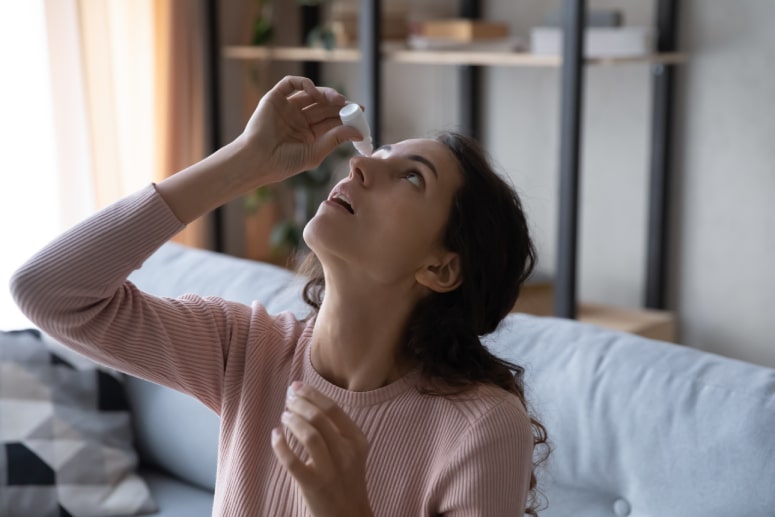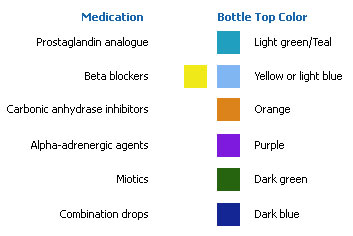Medical Treatment for Glaucoma
Medical Treatment for Glaucoma includes ophthalmic eye drops and oral medications (pills) to decrease elevated intraocular (inside the eye) pressure (IOP), which can damage the optic nerve that transmits visual information to the brain.

Medical Treatment For Glaucoma
When glaucoma is first diagnosed your doctor will usually prescribe an eye drop to help control your intraocular (internal eye) pressure to help preserve vision. Sometimes use of more than one eye drop is necessary to help control the intraocular pressure. Medical treatment is also, often used in conjunction with laser and surgical treatment of glaucoma. Currently there are five types of pharmacological compounds available to reduce intraocular pressure:
Mandated Color Coding

The FDA has mandated a color-coding of the bottle tops to help patients, doctors and pharmacists to better indentify the various drops available to treat glaucoma. All brand name drops and some generics adhere to these guidelines.
Your doctor may recommend that you use a combination of these drugs to help preserve your vision. Currently a few combo eye drops are available commercially. If using more than one eye drop at the same time, please be sure to leave a five minute gap between instillation of the two different eye drops, to ensure you do not wash out the previous eye drop. The conjunctival cul-de-sac can hold only a single eye drop, so putting more than a single drop leads to wastage and spillage. How to instill and use eye drops correctly.
Laser and Surgical Treatment of Glaucoma
If medical therapy for glaucoma is ineffective at halting the ongoing damage to the optic nerve and loss of vision, your eye doctor may recommend glaucoma surgery. There are many different types of surgery for glaucoma. Each one of them is performed in order to lower intraocular pressure. By lowering intraocular pressure, it is hoped that optic nerve damage and loss of vision can be halted. Often, incisional surgery is recommended after attempts with medications or lasers are unsuccessful.
Prostaglandin Analogue to Treat Glaucoma
Tips: Prostaglandin Analogues have single night time application.
This group of drugs reduces intraocular pressure by increasing drainage of aqueous humor through the uveo-scleral pathway (non-conventional route). They are convenient to use as a single night time application and are currently widely prescribed as first-line therapy for the management of glaucoma. They reduce intraocular pressure by about 30% from baseline and recent studies have shown a blunting of the nocturnal spikes in intraocular pressure, when we are asleep and lying flat.
This effectiveness combined with a once a day dosage have made this group of medications very popular. It is recommended to use these eye drops before bedtime as they do cause a slight amount of redness and irritation especially when starting treatment.
Commercially these compounds are available as the following eye drops:
- Xalatan (latanoprost)
- Travatan Z (travoprost)
- Lumigan (bimatoprost)
Adverse Effects of Prostaglandin Analogues
In initial studies, less than 5 percent of people who used this medication reported a gradual change in eye color, due to an increased amount of brown pigment in the iris of the treated eye. The change in eye color occurs slowly and may not be noticeable for several months to several years. Cosmetic changes such as an increase in growth and length of eyelashes along with increased periocular pigmentation have been noted with long-term use.
Other side effects from this medication can include stinging, blurred vision, eye redness, itching and burning. Cystoid macular edema and recurrences of herpetic eye disease have been reported. These drugs are contraindicated in patients with active intraocular inflammation (uveitis).
Beta Blockers to Treat Glaucoma
Tip: Beta Blockers are widely used and well tolerated.
This group of compounds helps reduce intraocular pressure by decreasing the production of aqueous humor into the eye. These drugs are widely used and are generally well tolerated.
Beta-blockers can change cardiac activity by decreasing the amount of blood the heart pumps out, which may reduce the pulse rate and/or slow down the heart’s response rate during exercise. Also they can cause constriction of the bronchial airways and are contraindicated in patients with known obstructive airway disease.
If you have experienced dropping spells, syncopal attacks, episodes of a low heart rate or suffer from COPD, emphysema or asthma, please be sure to let your doctor know as he/she may avoid prescribing this group of drugs for you. Rarely your doctor may prescribe a selective beta-blocker which is better tolerated by patients with known lung problems.
Commercially these compounds are available as eye drops for treatment of glaucoma:
Non-selective Beta Blockers Eye Drops:
Timolol, Timolol GFS, Timoptic XE in 0.25 %, 0.5%,
Istalol, Betimol,
Betagan (levobunolol), Optipranolol (metipranolol), Ocupress (carteolol),
Timoptic in Ocudose 0.25%, 0.5% (preservative-free)
Selective (Beta-2 selective) Eye Drops:
Betopic 0.5%, Betoptic-S 0.25% (beta-blocker)
Combination drops
Cosopt (generic Dorzolamide -timolol) [combination with a Carbonic anhydrase inhibitor]
Combigan [Timolol combined with Brimonidine, an Alpha-adrenergic agonist]
Adverse Effects of Beta Blockers
Beta blockers can also cause a shortness of breath in people who have a history of asthma or other respiratory disorders as discussed above. Side effects include low blood pressure, reduced pulse rate, fatigue and exercise induced shortness of breath. Rare side effects reported are reduced libido, depression and ocular allergies.
Carbonic Anhydrous Inhibitors to Treat Glaucoma
Tip: Carbonic Anhydrous Inhibitors are available as eyedrops and pill form.
This group of compounds helps reduce intraocular pressure by decreasing the production of aqueous humor into the eye. They are related to the sulfa group of drugs. If you have experienced a serious allergic reaction to a sulfa compound, before please be sure to let your doctor know. Very often patients with a known sulfa drug allergy tolerate these glaucoma medications well.
Commercially these compounds are available both as eye drops and pills:
Eye Drops – Carbonic Anhydrous Inhibitors:
Trusopt (generic: Dorzolamide 2%)
Azopt
Cosopt (generic Dorzolamide and timolol).
[This is a combination eye drop combined with a Beta-blocker]
Pill – Carbonic Anhydrous Inhibitors:
Diamox (generic: Acetazolamide)
Diamox 500mg SR capsules
Neptazane (generic: Methazolamide)
Adverse Effects of Carbonic Anhydrous Inhibitors
Eye drops can cause stinging and burning upon instillation. The pill forms of these medications can cause a sensation of tingling and numbness in the fingers and toes, as well as around the mouth. Some patients may experience an upset stomach with a metallic taste in the mouth. Frequent urination, fatigue, mental fuzziness, memory problems, depression, and kidney stones have been reported with use of these drugs. Since these pills lead to a loss of potassium from the body fluids, some these side effects can be avoided by keeping hydrated and using natural sources of potassium along with these pills, such as eating a banana a day or drinking plenty of orange juice, Gatorade or other energy drinks that replenish body salts.
Alpha-Adrenergic Agonists to Treat Glaucoma
Tip: Alpha-Adrenergic Agonists reduce intraocular pressure.
This group of compounds helps reduce intraocular pressure by both decreasing the production of aqueous humor into the eye as well as improving the drainage of aqueous fluid through the uveoscleral pathway. Also brimonidine has been shown in experimental animal models of glaucoma to have a neuroprotective effect (preserve existing neural axons). This as yet has to be validated clinically.
Commercially these compounds are available as eye drops:
- Alphagan P 0.1%, 0.15%
- Brimonidine 1.5%, 2%
- Iopidine 0.5%
- Combigan – This is a combination eye drop: brimonidine combined with a Beta-blocker
Your doctor may prescribe Alphagan (generic: brimonidine) or Combigan for the long-term treatment of glaucoma. Iopidine however is usually used in the clinic, and is rarely prescribed as a take-home medication. It is used in the clinic to combat “pressure spikes” which are sharp increases in eye pressure that sometimes follow laser surgery. The eye technicians will instill this drop in your eye as they prepare your eye for laser surgery.
Adverse Effects Alpha-Adrenergic Agonists
Include burning or stinging upon instillation of the eye drop. Allergic reactions including redness of the eye and eye lids are common with use of this group of drugs. Other side effects reported include fatigue, headache, dry mouth and dry nose. It should be used with care in children as can cause drowsiness and difficulty with breathing while asleep.
Miotics to Treat Glaucoma
Miotics are parasympathomimetic agents.
These drugs work by constricting the pupil as well as other internal muscles of the eye; as a result there is an increased drainage of aqueous humor through the trabecular meshwork, reducing intraocular pressure. Constriction of the ciliary muscle pulls on scleral spur widening the pore size in the filter (trabecular meshwork) through which the eye fluid needs to pass for effective drainage.
Due to their side effect profile these drugs are nowadays rarely used in the routine treatment of glaucoma. However in conditions such as narrow angle glaucoma and pigmentaty glaucoma these drugs are sometimes preferred. In narrow angle glaucoma, constriction of the pupil with these drugs helps open the angle and improve drainage of intraocular fluid. Your doctor may choose to use these drugs prior to or in conjunction with a laser procedure. In pigment dispersion and pigmentary glaucoma, miotic drugs work by changing the configuration of the iris and reducing liberation of pigment.
Commercially these compounds are available as eye drops:
- Pilocarpine 0.5%, 1%, 2%, 4% , Isopto Carpine, Pilocar, Pilopine,
- Pilostat,
- Pilogel 4%
- Ocusert Pilo 2%, 4%
- Carbachol, Isopto Carbachol
- Phospholine Iodide®
- (echothiophate iodide)
Adverse effects of Miotics
Brow ache, headache, eye pain, dim vision, especially at night or in darkened areas such as movie theaters. Also reported are redness and allergic reactions. In near-sighted individuals there is an increased risk of retinal detachment.

 DONATE NOW
DONATE NOW